Uwm cell bio 315 Final Exam
1/86
There's no tags or description
Looks like no tags are added yet.
Name | Mastery | Learn | Test | Matching | Spaced |
|---|
No study sessions yet.
87 Terms
1. Which of the following statements is false when comparing G proteins to Ras proteins?
a. Both of them need GDP-GTP exchange to switch on/off of their activity
b. G-protein are trimeric, however Ras proteins are monomeric
c. The activation of G proteins requires G-protein coupled receptors, whereas the activation of Ras proteins mostly depends on enzyme-linked receptors
d. Ras proteins are not involved in cell communication
Ras proteins are not involved in cell communication
2. Plant and animal cells use totally different signaling mechanisms for cell communication
a. True
b. False
False
3. MAP kinase cascade is important (and widespread) signal transduction pathway involved in regulation of transcription, replication and translation
a. True
b. False
True
4. The local mediator nitric-oxide stimulates the intracellular enzyme guanylyl cyclase by
a. Way of a G-protein-mediated mechanism
b. Way of a receptor tyrosine kinase
c. Diffusing into cells and stimulating the cyclase directly.
d. Way of a cell-surface receptor linked to an intracellular signaling pathway
Diffusing into cells and stimulating cyclase directly
5. Actin filaments are made up of dimers, consisting of a-actin and B-actin subunits
a. True
b. False
False
6. The role of calcium in muscle contraction is:
a. Detach myosin heads from actin
b. To bind to troponin complex to induce the change of tropomyosin, exposing actin filaments to myosin heads
c. To maintain the structure of the myosin filament
d. All of the above
To bind to tryponin complex to induce the change of tropomyosin, exposing actin filaments to myosin heads
7. Levels of cyclin-dependent kinase (Cdk) activity change during the cell cycle as a result of
a. The Cdk phosphorylation each other
b. The Cdks activating the cyclins
c. The level of production of Cdks changing throughout the cell cycle
d. The Cdks binding different cyclins to become active.
The Cdks binding different cyclins to become active
8. What will be the possible effect if the dividing cells are exposed under strong radiation?
a. The cell division will be halted
b. The checkpoint mechanisms will be activated to repair the DNA damage
c. Cell will be divided at a normal pace.
d. A and B
A and B
9. Centrosomes are replicated independently of chromosomes
True or False?
True
10. Which of the following statement is false in describing the assembly of spindles?
a. Chromosomes create a local environment that favors both microtubule nucleation and microtubule stabilization.
b. The assembly of functional bipolar spindles requires centrosomes in all cell types
c. Motor proteins play a crucial part in the assembly of spindles
d. Not all the microtubules in the spindle attach to chromosomes.
The assembly of functional bipolar spondles require centrosomes in all cell types
11. Which of the following statements is false?
a. Asexual reproduction typically give rise to offspring that are genetically identical
b. Germ-line cells have half the number of chromosomes as somatic cells
c. Sexual reproduction allows for a wide variety of gene combinations
d. A zygote can only be produced through asexual reproduction.
A zygote can be produced by asexual reproduction
12. Which of the following is NOT a shared feature of mitosis and meiosis:
a. DNA replication
b. Chromosomes lining up on metaphase plate
c. Chromosomes lining up in a bivalent
d. Cytokinesis
Chromosomes lining up in a bivalent
13. Finding co-inheritance of a SNP variant and a disease tells scientists that:
a. Everybody who carries this SNP will get the disease
b. Sequences within the SNP cause the disease
c. A gene important for causing the disease is linked to the SNP
d. SNPs on other chromosomes will not be co-inherited with the disease
A gene, important to causing the disease is linked to the SNP
14. Which of the following statements about genome-wide association studies (GWAS) is false?
a. GWAS can be used even if more than one gene can cause the disease of interest
b. Sometimes GWAS will identify SNPs that are associated with a disease but these SNPs do not affect the gene product of the gene that causes the disease.
c. Studies using GWAS only examine SNPs that occur very rarely in the population, as those SNPs are most likely to cause disease.
Studies using GAWS only examine SNPs that occur very rarely in the population, as those SNPs are more likely to cause disease
15. Cancers that arise due to mutated tumor suppressor genes requires that
a. One allele of the gene undergoes mutation
b. Both alleles of the gene undergo mutations
c. Neither allele of the gene undergo mutation
d. None of the above.
Both alleles of the gene undergo mutations
16. When a trimeric G protein is activated by a cell-surface receptor, the consequence will be
a. The B subunit exchanges its bound GDP for GTP
b. The GDP bound to the a subunit is phosphorylated to form bound GTP
c. It dissociates into a free B subunit and an a subunit
d. The a subunit exchanges its bound GDP for GTP
e. It dissociates into an active a subunit and an inactive By subunit
It dissociates into an active subunit and an inactive by subunit
17. Which of the following statements about tumor suppressor genes is false?
a. Gene amplification of a tumor suppressor gene is less dangerous than gene amplification of a proto-oncogene
b. Cells with one functional copy of a tumor suppressor gene will usually proliferate faster than normal cells
c. Inactivation of tumor suppressor genes leads to enhanced cell survival and proliferation.
d. Individuals with only one functional copy of a tumor suppressor gene are more prone to cancer than individuals with two functional copies of a tumor suppressor gene.
Cells with one functional copy of the tumor suppressor gene are likely to proliferate faster than those with two functional suppressor genes
18. Drugs that block the function of oncogenic proteins hold great promise in the fight against cancer. Cancer researchers should be attempting to design drugs that will interfere with the products of tumor suppressors.
a. True
b. False
False
19. An antibody that binds to myosin prevents the movement of myosin molecules along actin filaments. What might be the result of injecting this antibody into dividing cells?
a. Chromosome movement at anaphase will be arrested
b. Cytokinesis will be arrested
c. Spindle will not be formed
d. DNA replication will be arrested
Cytokinesis is arrested; actin doesn't separate cell membranes
20. Which of the following statements is true?
a. Kinetochore proteins bind to the tubulin molecules at the minus end of microtubules.
b. Sister chromatids are held together by condensins from the time they arise by DNA replication until the time they separate at anaphase.
c. Microtubule-dependent motor proteins and microtubule polymerization and depolymerization are mainly responsible for the organized movements of chromosomes during mitosis
Micro-tubule dependent proteins and micro-tubule polymerization and depolymerization are mainly responsible for the organized movements of chromosomes during mitosis
21. Proteoglycans are characterized by the abundance of negative charges on their sugar chains. These allow attracting a cloud of positive ions, which by osmosis draw in large amounts of water
a. True
b. False
True
22. Fibroblasts organize the collagen of the extracellular matrix by
a. Cutting and rejoining the fibrils
b. Crawling along existing fibrils and adjusting the packing of collagen molecules within them
c. Crawling over and pulling the collagen, then compact it into sheets or cables after it has been secreted
d. Controlling the local Ca+2 concentration so as to regulate collagen assembly
Controlling the local Ca+2 concentration so as to regulate collagen assmebly
1. Gap junctions connect the cytoskeleton of one cell to that of a neighboring cell or to the extracellular matrix
a. True
b. False
False; GAP junctions allow water and small nonpolar molecules to pass from cell to cell. Adherin junctions anchor actin-actin or actin-extracellular matrix
2. The replacement of GDP with GTP in G protein alpha subunit causes the dissociation of G protein trimeric complex. The dissociated subunits can relay the signal to downstream target. What are the consequences if the GDP affinity for the alpha subunit is reduced by a mutation?
a. The mutant G protein would be almost continuously activated
b. The activation of the G protein is still dependent on the activation of the G protein linked receptor
c. The activation of the mutant G protein stays normally
d. None of the above
The mutant G protein would be almost continuously active, no GDP inactivation; sticks with GTP
3. Compared to mitosis, which is not the special feature of meiosis?
a. One DNA replication follows two rounds of nuclear division
b. Long complex prophase I, when DNA recombination occurs
c. Products are genetically different
d. Cytokinesis
Cytokinesis
. Lamellipodia and filopodia are feelers that a cell extends to find anchor points on the substratum that it will then crawl over
a. True
b. False
True: filo=foot, podia=leg
The cell surface receptors can rapidly relay the signal to the nucleus by activating latent gene regulatory proteins such as STATs at the plasma membrane, why do most cell-surface receptors not use the shortcut but use long indirect cascades to influence gene transcription in the nucleus?
a. Amplify the signal
b. Integrate signals from different pathways
c. Spread the signal along divergent paths
d. All of the above
All of the above
Nucleotide hydolysis plays a similar role in both actin and tubulin polymerization.
True
What does a target cell do?
Converts an extracellular signal into an intracellular signal
What are the three purposes of cell communication?
1)Intracellular Communication
2)Environmental Monitoring
3)Response to Stimuli
What are the 4 forms of cell signaling?
1) Endocrine: Far distance (hormones)
2)Paracrine: Local Mediator
3)Neuronal: Nerve Synapse (Neurotransmitter)
4)Contact Dependent: Membrane bound signal molecule
What is Cyclic AMP Pathway for activation of enzyme pathway?
Signal binds to GCPR-Activates cyclase-intracellular cAMP-activates PKA-PKA moves into nucleas and activates transcription regulators-proteins stimulate whole transcription of target genes
Signal->Cyclase->Intracellular cAMP->PKA->Transcription regulators-> target genes expressed
Enzyme linked receptor, RTK activate Monomeric GTPase Ras, know the mechanism of Ras activating MAP-kinase
RTK activation stimulates the assembly of an intracellular signaling complex. RTKs activate Ras, which then activates MAP-kinase
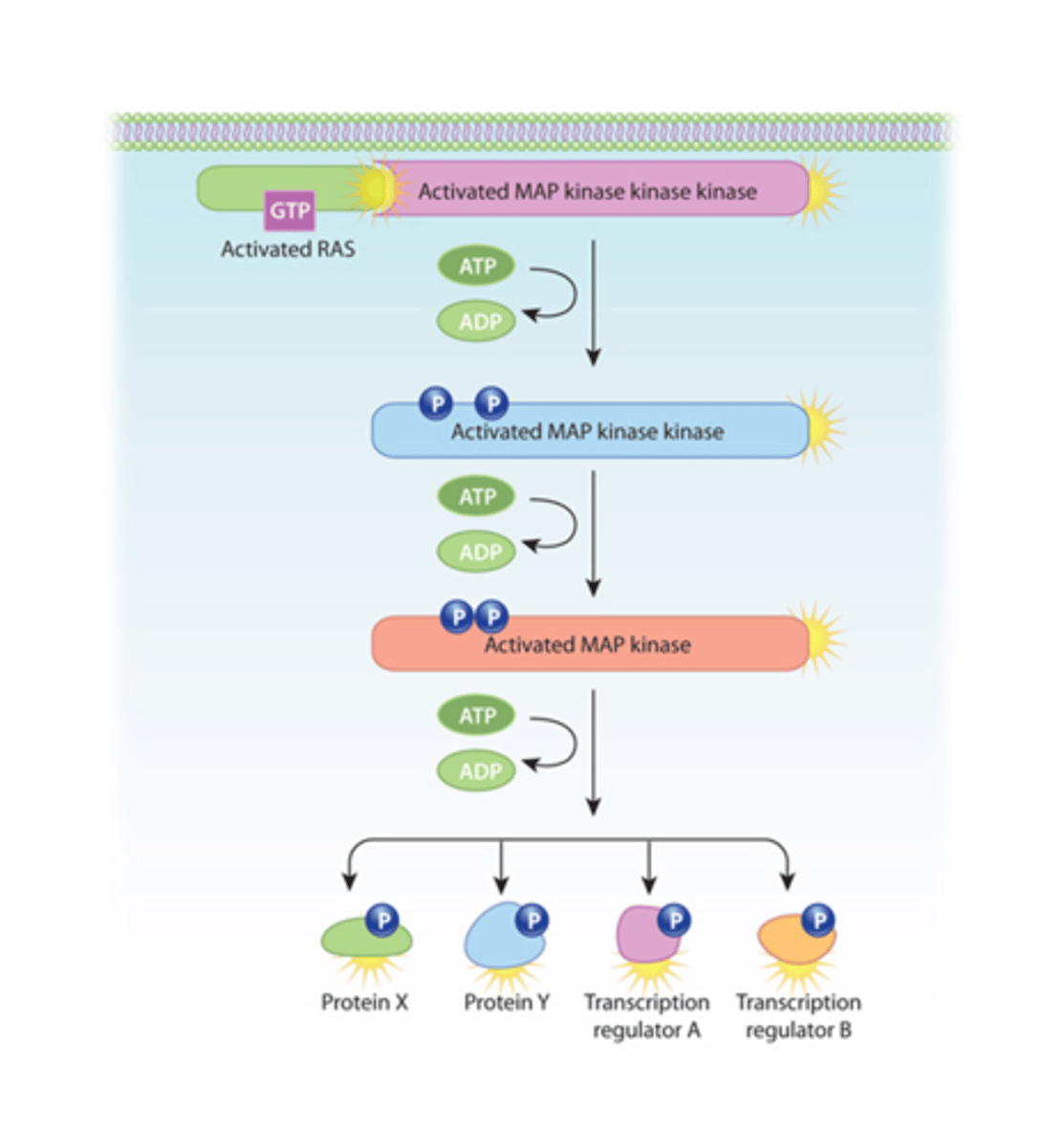
--activated Ras activates three kinase signaling module, which relays signal. Final kinase module, MAP kinase, phosphorylates various downstream signaling or effector proteins. These proteins can include other protein kinases, and most importantly transcription regulators that control gene expression. Resulting changes in gene expression and protein activity lead to complex changes in cell behaviors such as proliferation and differentiation.
--activated Ras activates three kinase signaling module, which relays signal. Final kinase module, MAP kinase, phosphorylates various downstream signaling or effector proteins. These proteins can include other protein kinases, and most importantly transcription regulators that control gene expression. Resulting changes in gene expression and protein activity lead to complex changes in cell behaviors such as proliferation and differentiation.
What is the mechanism of how Akt promotes cell survival and inhibit apoptosis?
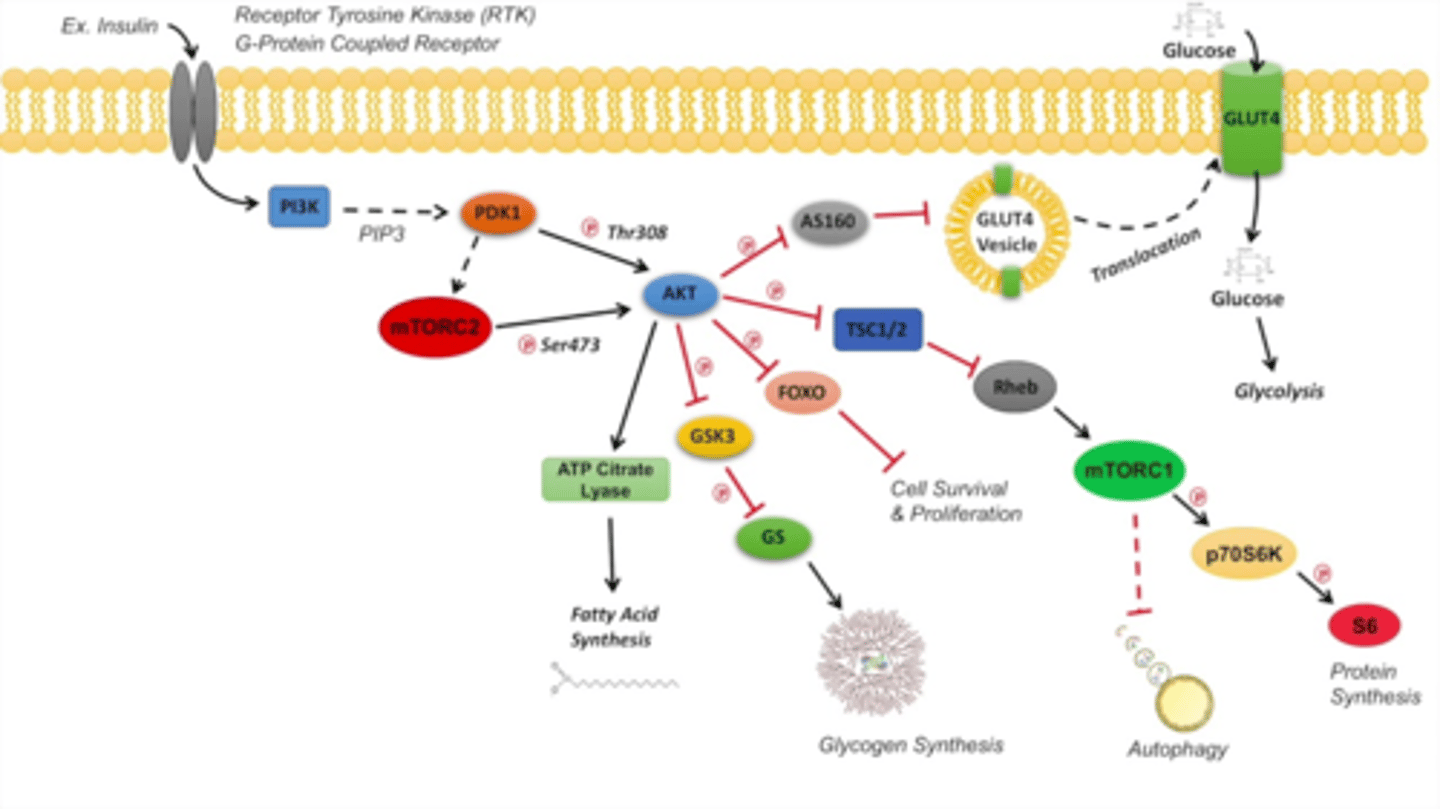
Why do cells need multiple signals to survive?
Each signal is for different things, some to survive, some to grow, some to differentiate
What type of signals act slowly?
Growth and Division because they have to change gene expression
How do large and hydrophilic signal molecules get inside plasma membrane?
--they bind to cell-surface receptors which in turn generate one or more signaling molecules inside cell.
--small hydrophobic extracellular molecules diffuse across target cells and activate enzyme or bind to intracellular receptor in either cytosol or nucleus.
How does cortisol activate?
cortisol diffuses across membrane and binds to receptor protein, hormone receptor complex gets inside nucleus and binds to specific regulatory sequence in DNA and activates the transcription of specific target genes.
How do extracellular signals change behavior of cells?
They act via cell surface receptors
What does the proposed divergence model of plant and animal entails?
Multicellularity and cell communication evolved independently in plants and animals
What protein phosphorylates signals? Which one dephosphorylates?
Protein Kinase: Add P
Protein Phosphatase: Take P
What is the mechanism of activated GPCR?

What happens to alpha subunit when a target protein is attached?
protein is activated, activated alpha subunit hydrolyze GTP to GDP which inactivates alpha subunit and it dissociates from protein. Inactive alpha subunit binds to BY again. Review above pic again.
What do enzyme linked receptors do?
-Promote growth, Proliferation, differentiation or survival of cells
-Act as local mediator at low concentration
-Responses are typically slow
-Has one transmembrane segment and enzyme activity in cytosolic domain or can bind to an enzyme
What type of phosphorylation is possible by tyrosine kinases?
auto or trans phosphorylation which is powered by ATP
kinase can phosphorylate itself or partner
What are dominant negative effects of receptor tyrosine kinase?
-mutation in tyrosine kinase can result in no activation.
What subunit of the cytoskeleton do plants not have?
Plants dont have intermediate filaments, only micro-tubule and actin
What is the strength of IF like against mechanical stress?
It is more susceptible to physical change. IFs strengthen animal cells from rupturing.
How do microtubules form?
Alpha and beta subunits add together to make protofilament, 13 protofilaments add together to make microtubule.
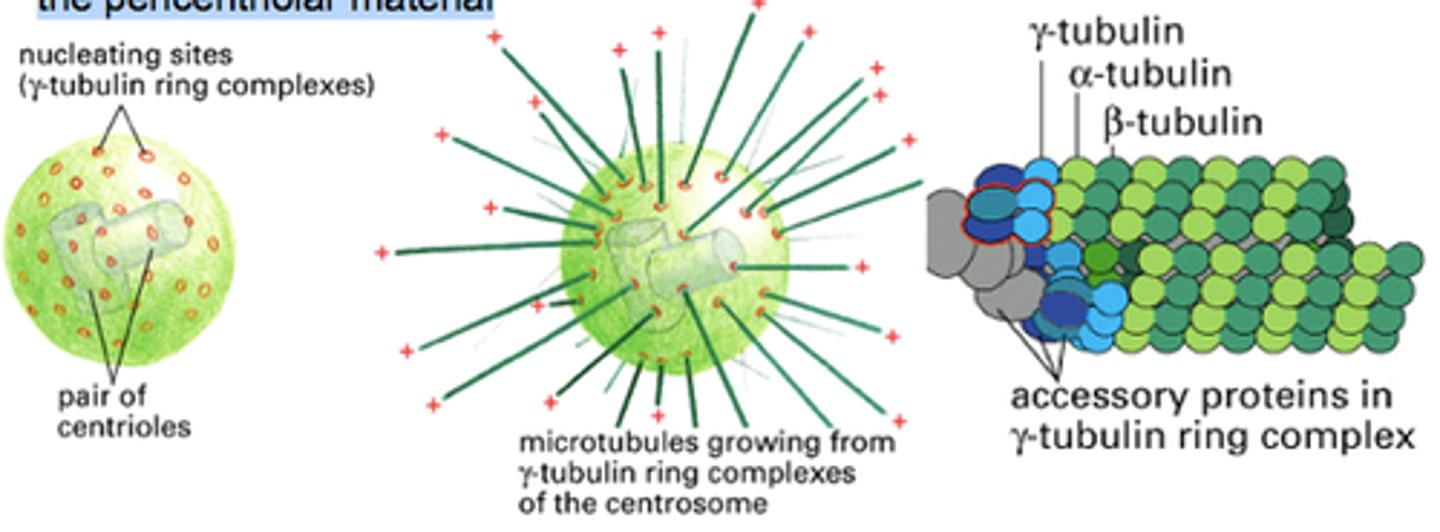
What are nucleating sites?
y-tubulin polymerizes from these sites located on a centrosome, microtubules grow from y-tubulin ring (nucleating sites) towards + end.
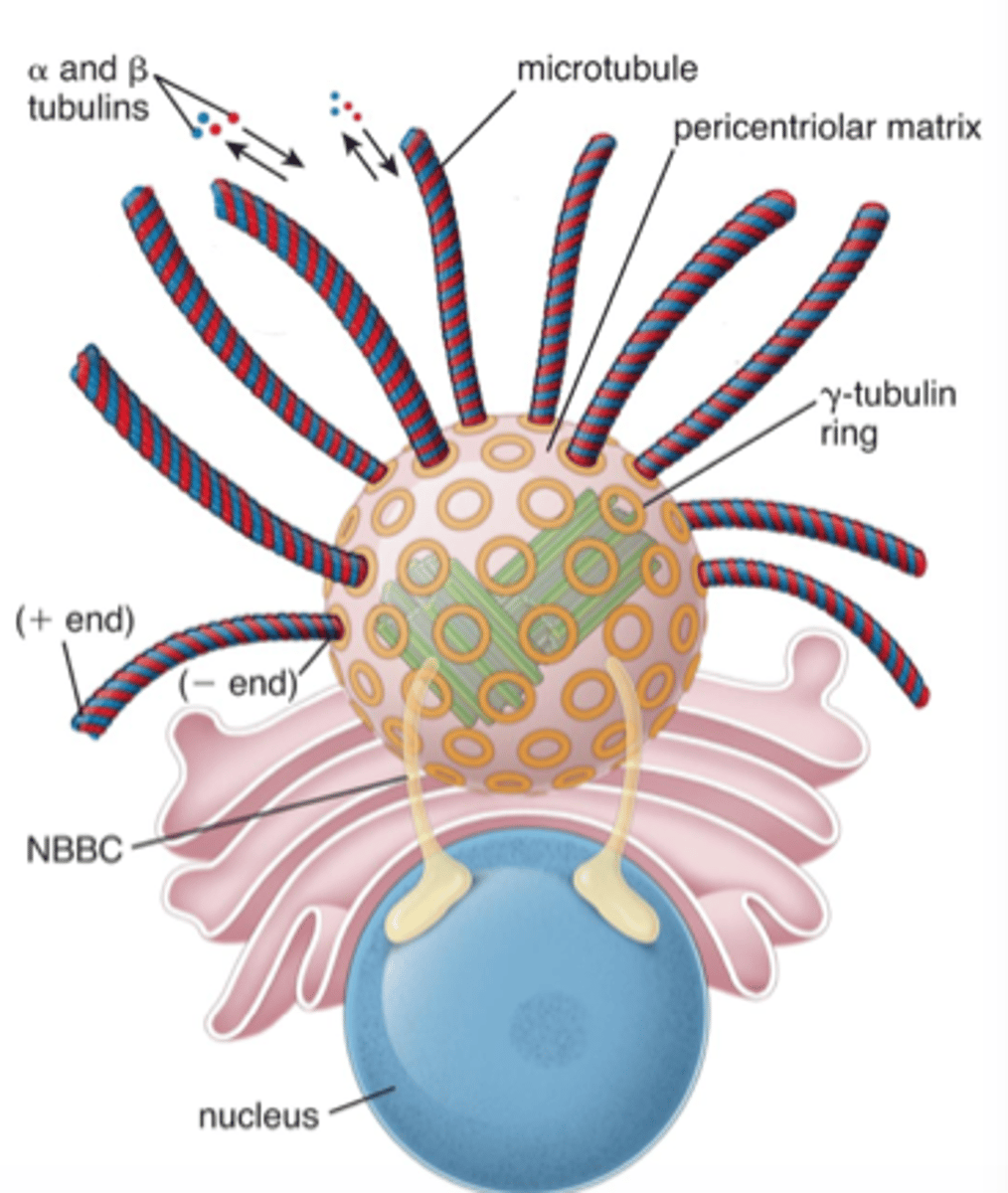
What controls the growth of microtubules?
GTP hydrolysis controls growth of microtubules. Tubulin dimers bind GTP more tightly hence making a GTP cap which allows microtubules to keep growing, sometimes GTP hydrolyze to GDP which diminishes GTP cap and microtubules keep shrinking. This mechanism is called dynamic instability.

What is the difference between actin filaments and microtubules?
Actin is thin and flexible and shorter than microtubules, but more individuals, over 30X more than microtubules in a cell
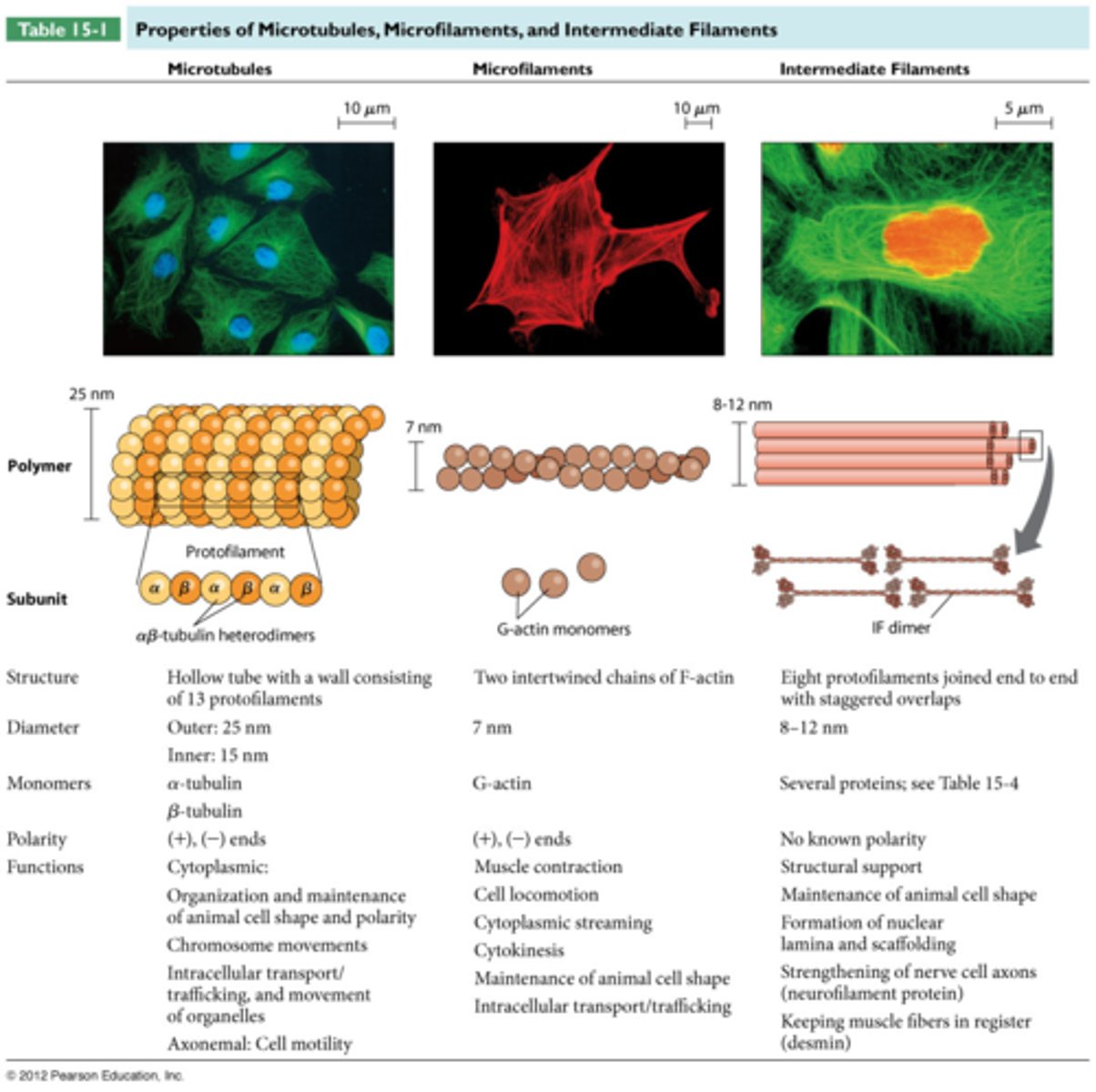
How do cells manage to crawl?
lamellipodia and filopodia are feelers that a cell extends to fit anchor points on the substratum that will then make it crawl over.
What are z-discs and what do they do?
muscle contraction is about shortening of z-discs (sarcomeres) not the actin or myosin filaments. Upon signal bipolar myosin filaments on actin filaments bring z-discs together.
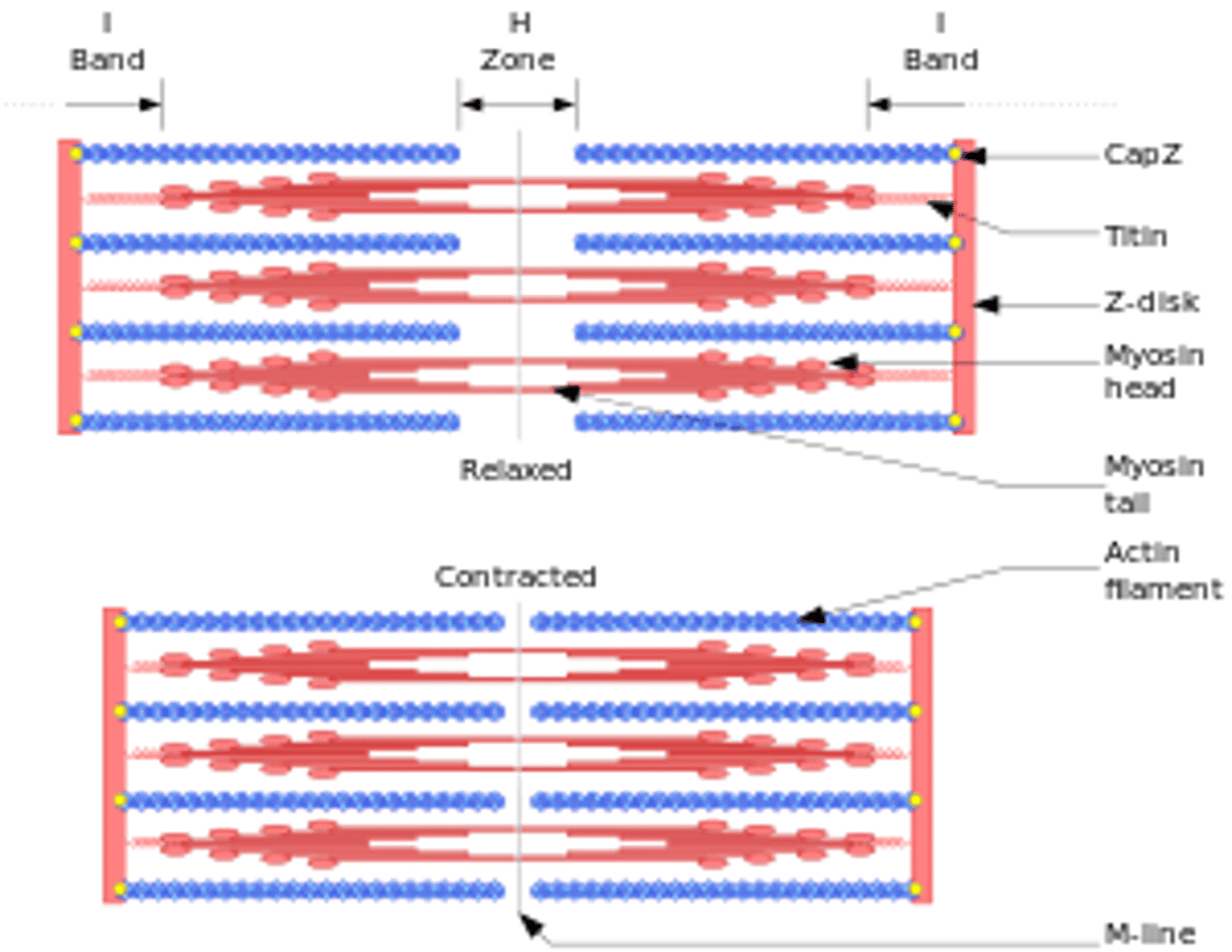
What does it mean when Ca ion binds?
--muscle contraction is triggered by sudden rise in cytosolic Ca++. when level of Ca in cytosol raised, Ca binds to troponin complex and induces a change in its shape. The tropomyosin shift its position slightly. Myosin head bind to the actin filaments and contraction is initiated.

What is the G0 stage in G1 phase?
It is a specialized resting state
What type of mutations make conditional mutants?
Temperature sensitive cell division cycle (cdc) mutants can be studied and become conditional mutants. The cell cycle control system can be dissected genetically in yeasts.
What different types of cyclin-cdk complexes trigger different steps in cell cycle?
Accumulation of cyclin regulates activity of Cdk. cyclin-Cdk complex enzymatic activity rises and falls during the course of cell cycle, concentration of Cdk component does not. M-cdk S-cdk start S-cdk end
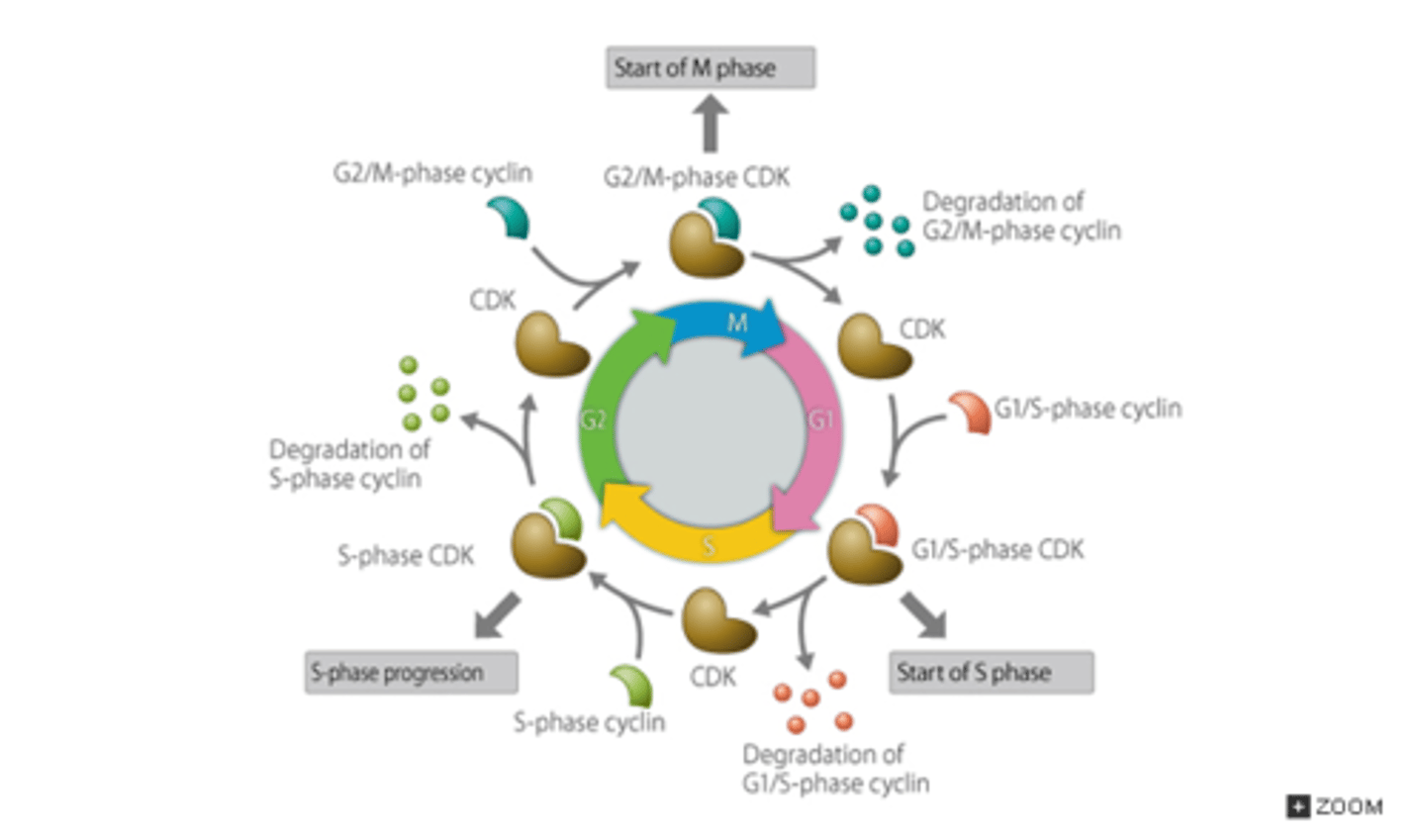
What does cyclin-Cdk complex activity depend on?
It depends on phosphorylation and dephosphorylation. When first formed cyclin-Cdk complex is not phosphorylated and is inactive. Then Cdk is phosphorylated at a site that is required for activity and at two other sites that are inhibitory. It is still inactive until protein phosphatase comes in and removes 2 inhibitory phosphates which activates complex.
What is the point of a checkpoint in G1 phase?
The cell can either continue with cell cycle and enter S phase, pause at G0 phase or permanently withdraw through G0 phase.
What is the mechanism of how DNA damage can arrest cell cycle at G1 phase?
When DNA is damaged specific protein kinases phosphorylates p53 protein which stops it from degrading prematurely. Activated p53 accumulates and binds to DNA then it does transcription of p21 gene which encodes for Cdk inhibitor protein. P21 binds to G1/S-Cdk and S-Cdk which inactivates it so cell cycle arrests at G1 phase.
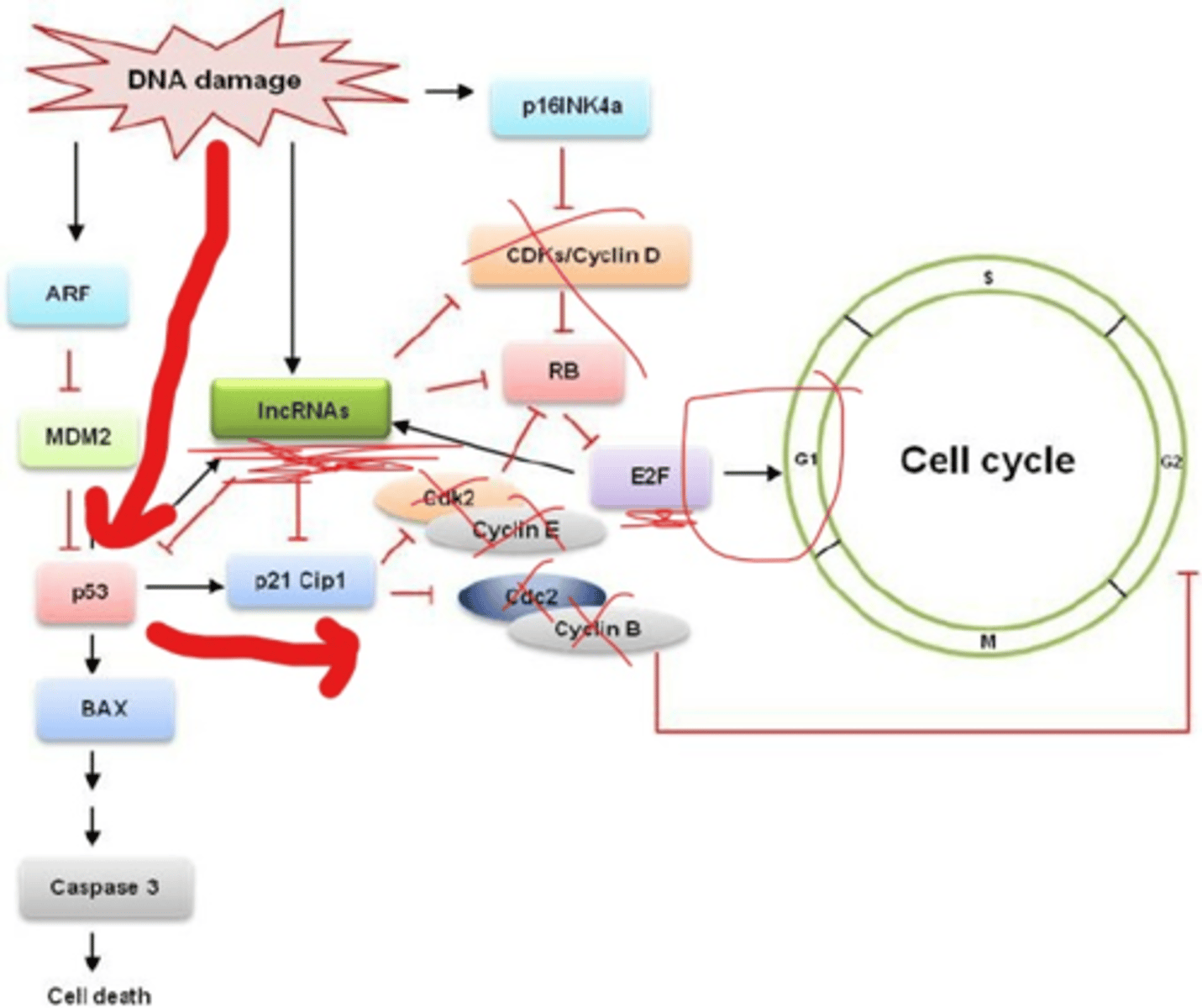
What is the function of cohesin and condensins?
Cohesin hold replicated DNA together, it ties two adjacent sister chromatids in each replicated chromosome. (2N)
Condensins condense DNA by forming coils in mitotic chromatids and making it more compact and small. (4N)
What is a bipolar mitotic spindle and how is it formed?
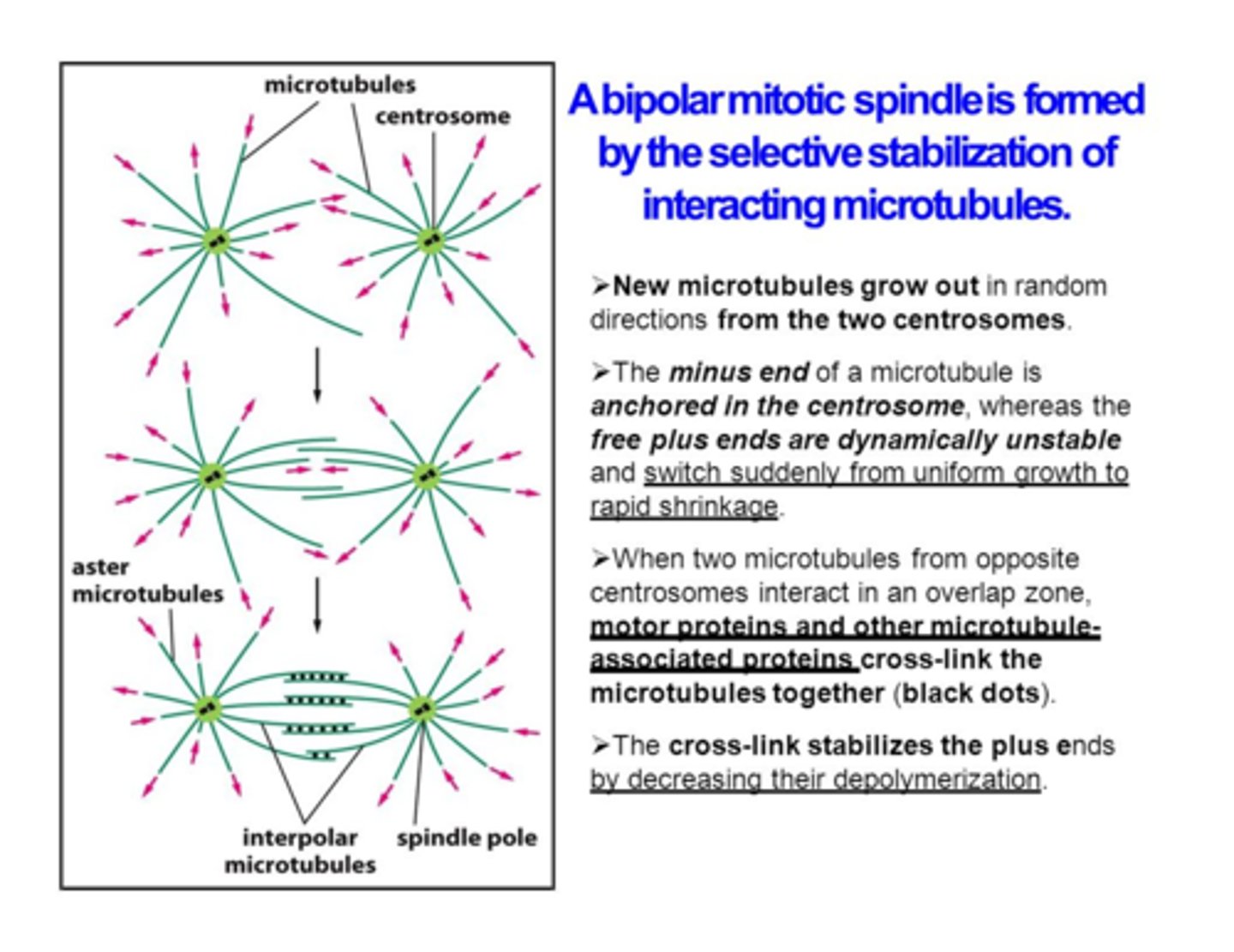
What are all the stages of the M phase? Briefly describe each stage just in case.
● Prophase: sister chromatids, condense. Mitotic spindles assemble.
● Prometaphase: breakdown of nuclear envelope. Chromosomes attach to spindle microtubules via kinetochores
● Metaphase: chromosomes align in the middle.
● Anaphase: sister chromatids separate
● Telophase: nuclear envelope reassembles
● Cytokinesis: cytoplasm is divided into two.
How do spindles form in structure that do not have centrosomes?
Motor proteins and chromosomes can direct assembly of functional bipolar spindle in absence of centrosome. Spindles with centrosome has aster at each pole whereas spindle formed without centrosome does not.
How is cytokinesis different in plants and animals?

What is the difference between sexual and asexual reproduction?
asexual reproduction results in offsprings with same genetic makeup as the parent
What is the mechanism of intrinsic apoptotic death program regulated by intracellular/extracellular(signals) proteins? (figure 18-40)
● Cytochrome c is released from mitochondria which can activate procaspases within apoptosome.
● Procaspases can be activated by either internal or external cell signals
● Activated caspase molecules can activate other inactive caspase molecules.
● Procaspases share the feature of being activated by proteolytic cleavage.
During meiosis I homologous chromosomes are paired at metaphase plate, what is the structure called when replicated chromosomes come together?
Bivalent is formed when replicated chromosomes come together during meiosis. (4N)
What is created between non-sister chromatids in each bivalent after crossover event?
A chiasmata is created, it is the point where two homologous chromosomes exchange genetic material.
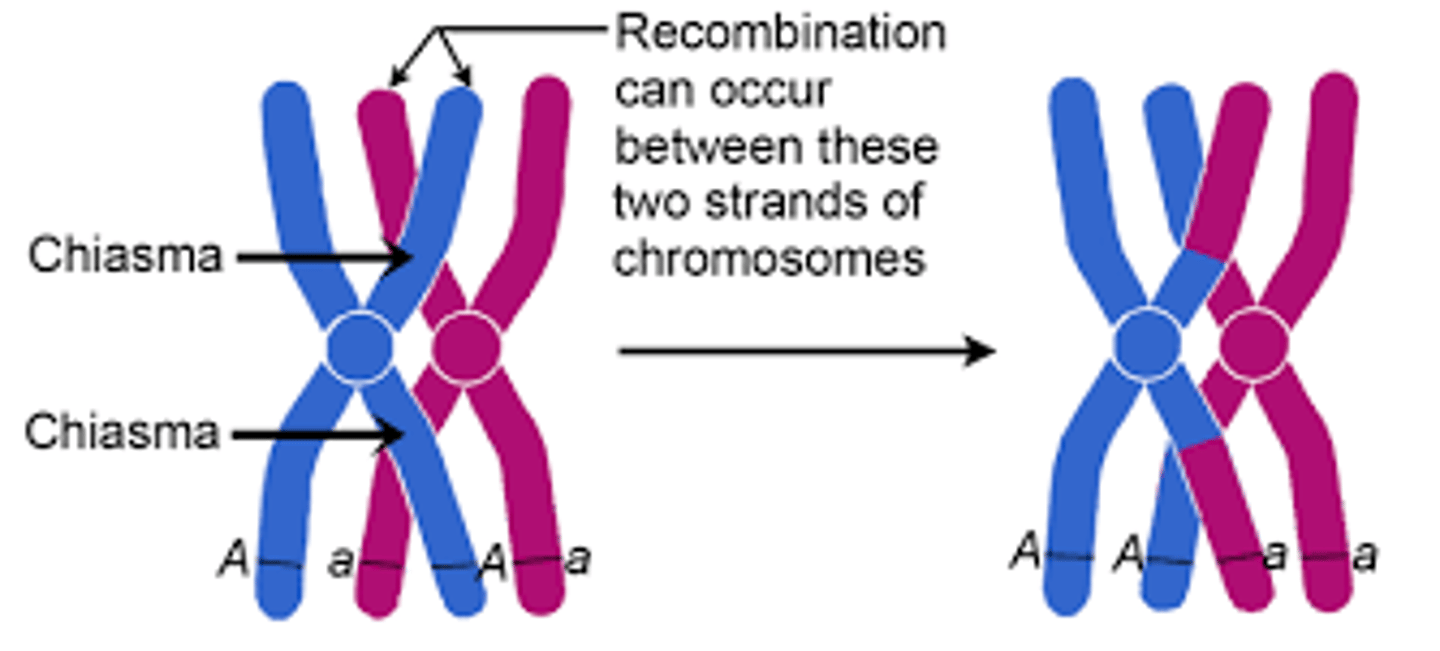
What kind of mutation would form a conditional mutant?
Substitution would cause that because it sometimes does not change anything, so it is not detrimental. It could change amino acid or create stop codon. Insertion and nucleotide deletion are detrimental because they change the reading frame.
What are the two kinds of reassortment that generate new chromosome combinations during meiosis?
● Random distribution: independent assortment of maternal and paternal homologs.
● Crossing over
What is a complementation test?
It is used to determine whether different recessive mutations affect the same gene or locus (are alleles) or whether they affect different genes. Noncomplementation is when two independent mutations are in the same gene, the offspring of two mutants has a hybrid who is also a mutant.
What are SNPs?
Single-nucleotide polymorphisms are sites in the genome where two or more alternative choices of a nucleotide are common in the population. They differ in about 1 nucleotide pair per 1000 nucleotides.
What is GWAS?
Genome-wide association studies focus on SNPs which helps us discover common genetic variants that affect the risk for common diseases.
What is forward and reverse genetics?
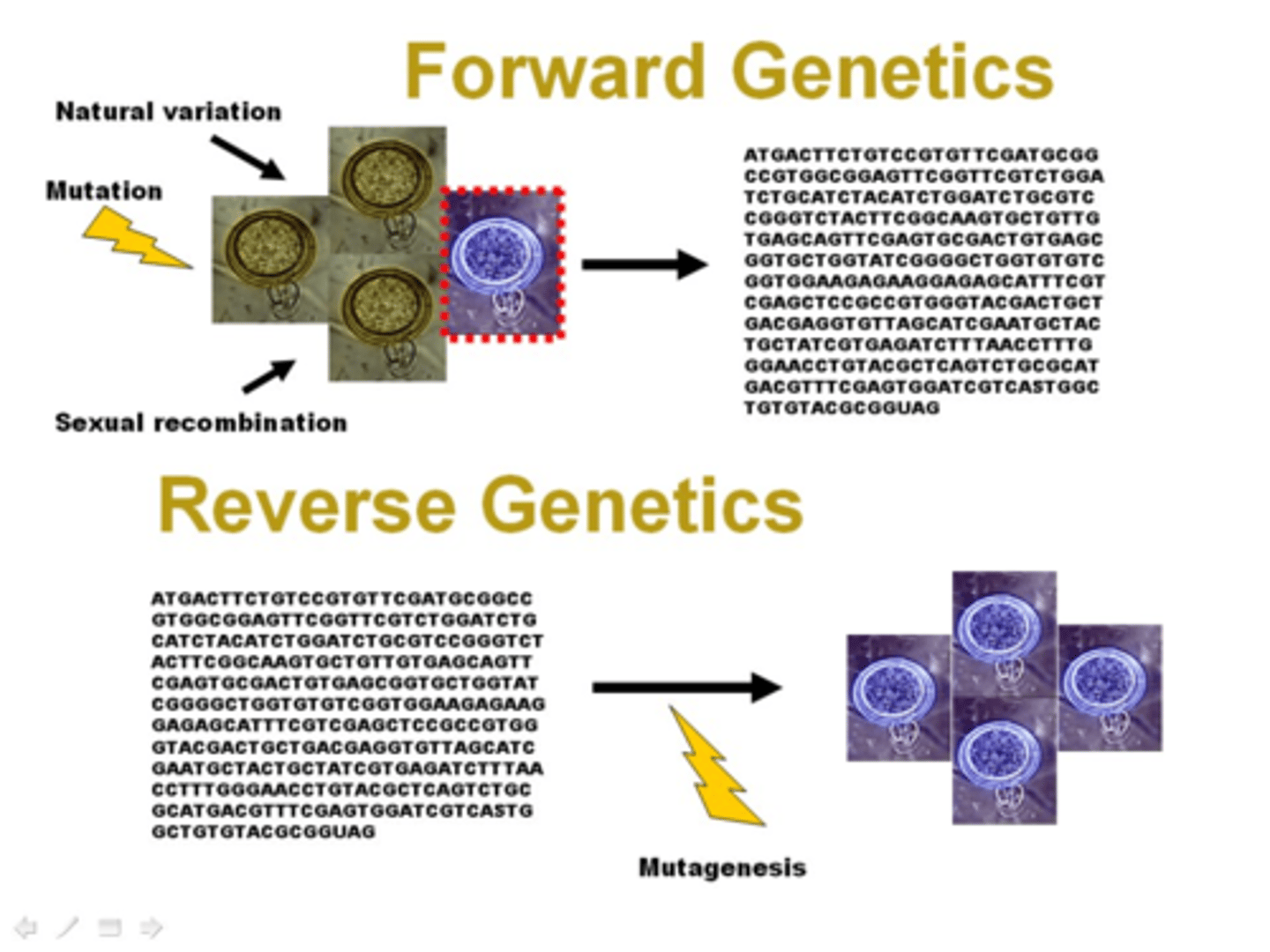
Several types of cell junctions are found in epithelial cells what are they?
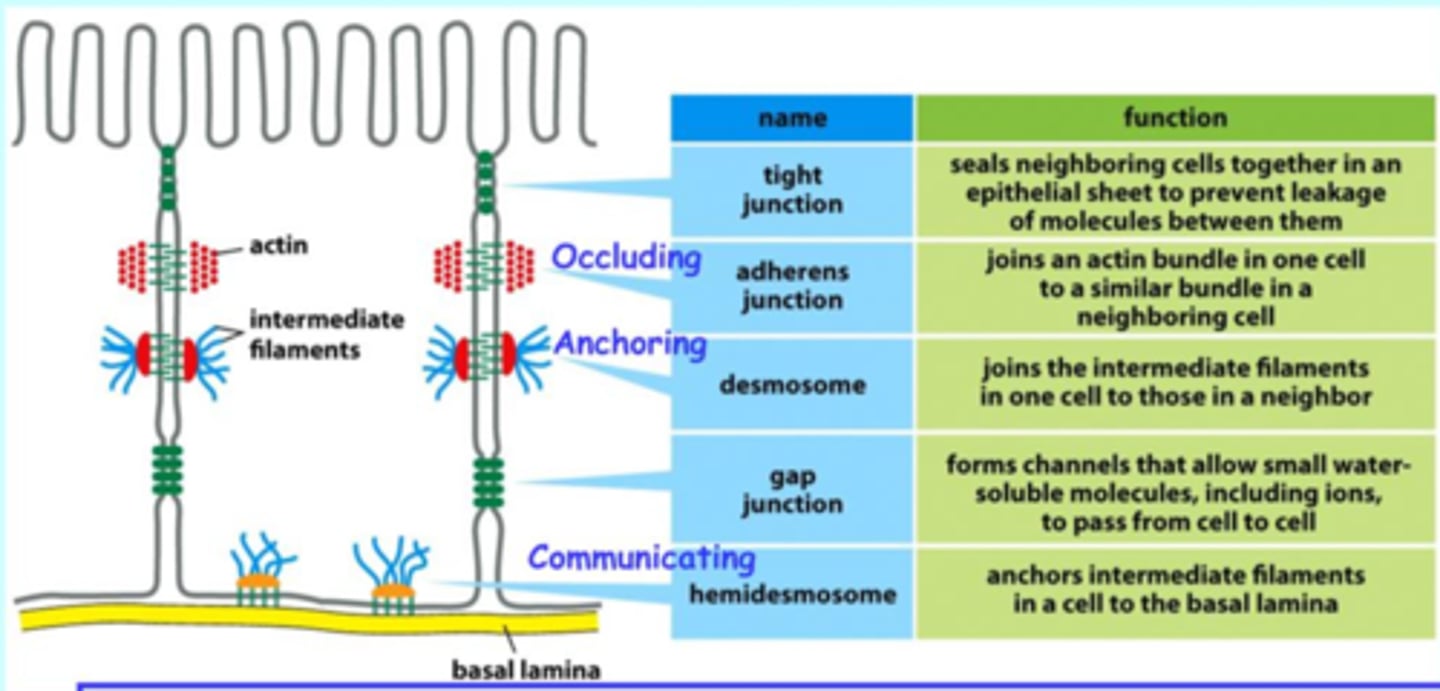
What kinds of things are in the extracellular matrix?
Collagen, Cellulose, GAGS

Cells can be packed together in different ways to form an epithelial sheet, what are those ways?
• Glycosaminoglycans are linked to proteoglycan.
• Proteoglycans can act as filters to regulate which molecules pass through the extracellular medium.
• The negative charge associated with proteoglycans attracts cations, which cause water to be sucked into the extracellular matrix.
• Proteoglycans help tissues resist compression
• Seal cells so there's no leakage-occluding
• Allows cells to communicate-communicating junctions.
What are the key factors that maintain the cellular organization of tissues?
cell communication, selective cell-cell adhesion (cell matrix, similar cells stick together), cell memory (preserve identity that the cell has created)
What is stem cell therapy?
idea that induced pluripotent stem cells (IPs) can be generated by direct transformation of cells from adult tissues. Although stem cells are not differentiated, they can be specialized and therefore give rise to specific cell types.
What genes are critical for cancer?
Tumor Repressing Protein mutation. Proto-onogenesis

Do tumor cells have high p53 or low p53?
tumor cells do not have p53: keeps cells in G1 by inhibiting cdk synthesis
What's the difference between Benign tumor and Metastasis?
benign tumor is encapsulated with fibrous connective tissue. Metastasis is invasive cancerous cells that proliferate and cause cancer in other parts of the body
Mutations in what genes could cause cancer?
APC
Cyclin D
Ras
Bcl2
p53
What are the steps that describe how does colorectal cancer occur?
a. Cancer results from accumulation of mutations in somatic cell.
b. Some of the newly accumulated mutation in key genes give the cell an increased ability to survive, proliferate and metastasize, resulting in invasive cancer
c. Cell signaling proteins are important for tumor formation.
d. P53 is a protein that is activated and stabilized when DNA is damaged.